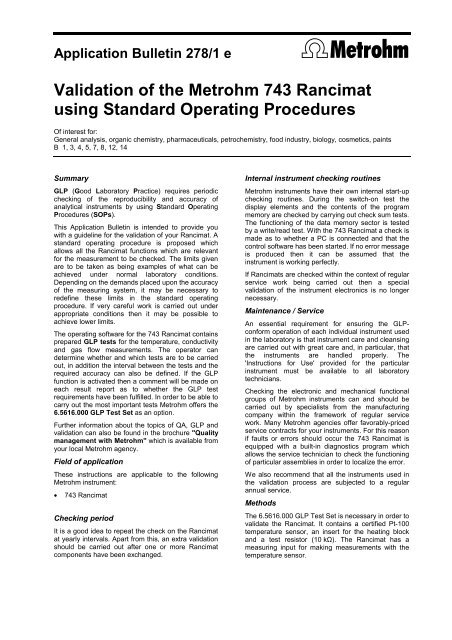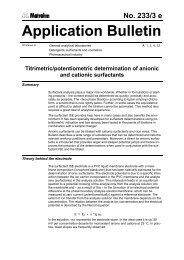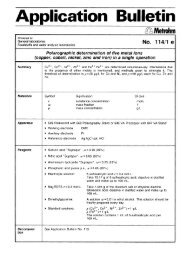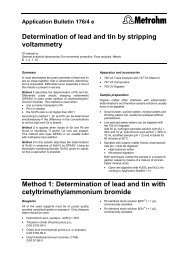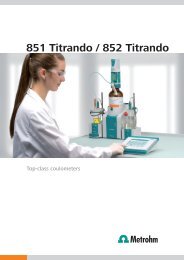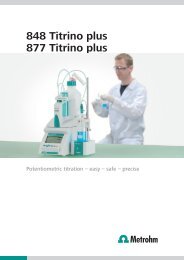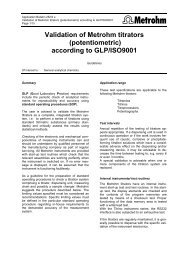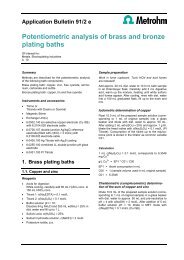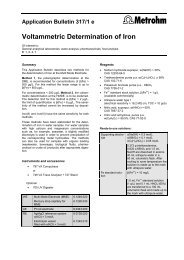Validation of the Metrohm 743 Rancimat using Standard Operating ...
Validation of the Metrohm 743 Rancimat using Standard Operating ...
Validation of the Metrohm 743 Rancimat using Standard Operating ...
- No tags were found...
Create successful ePaper yourself
Turn your PDF publications into a flip-book with our unique Google optimized e-Paper software.
Application Bulletin 278/1 e<strong>Validation</strong> <strong>of</strong> <strong>the</strong> <strong>Metrohm</strong> <strong>743</strong> <strong>Rancimat</strong><strong>using</strong> <strong>Standard</strong> <strong>Operating</strong> ProceduresOf interest for:General analysis, organic chemistry, pharmaceuticals, petrochemistry, food industry, biology, cosmetics, paintsB 1, 3, 4, 5, 7, 8, 12, 14SummaryGLP (Good Laboratory Practice) requires periodicchecking <strong>of</strong> <strong>the</strong> reproducibility and accuracy <strong>of</strong>analytical instruments by <strong>using</strong> <strong>Standard</strong> <strong>Operating</strong>Procedures (SOPs).This Application Bulletin is intended to provide youwith a guideline for <strong>the</strong> validation <strong>of</strong> your <strong>Rancimat</strong>. Astandard operating procedure is proposed whichallows all <strong>the</strong> <strong>Rancimat</strong> functions which are relevantfor <strong>the</strong> measurement to be checked. The limits givenare to be taken as being examples <strong>of</strong> what can beachieved under normal laboratory conditions.Depending on <strong>the</strong> demands placed upon <strong>the</strong> accuracy<strong>of</strong> <strong>the</strong> measuring system, it may be necessary toredefine <strong>the</strong>se limits in <strong>the</strong> standard operatingprocedure. If very careful work is carried out underappropriate conditions <strong>the</strong>n it may be possible toachieve lower limits.The operating s<strong>of</strong>tware for <strong>the</strong> <strong>743</strong> <strong>Rancimat</strong> containsprepared GLP tests for <strong>the</strong> temperature, conductivityand gas flow measurements. The operator candetermine whe<strong>the</strong>r and which tests are to be carriedout, in addition <strong>the</strong> interval between <strong>the</strong> tests and <strong>the</strong>required accuracy can also be defined. If <strong>the</strong> GLPfunction is activated <strong>the</strong>n a comment will be made oneach result report as to whe<strong>the</strong>r <strong>the</strong> GLP testrequirements have been fulfilled. In order to be able tocarry out <strong>the</strong> most important tests <strong>Metrohm</strong> <strong>of</strong>fers <strong>the</strong>6.5616.000 GLP Test Set as an option.Fur<strong>the</strong>r information about <strong>the</strong> topics <strong>of</strong> QA, GLP andvalidation can also be found in <strong>the</strong> brochure "Qualitymanagement with <strong>Metrohm</strong>" which is available fromyour local <strong>Metrohm</strong> agency.Field <strong>of</strong> applicationThese instructions are applicable to <strong>the</strong> following<strong>Metrohm</strong> instrument:• <strong>743</strong> <strong>Rancimat</strong>Checking periodIt is a good idea to repeat <strong>the</strong> check on <strong>the</strong> <strong>Rancimat</strong>at yearly intervals. Apart from this, an extra validationshould be carried out after one or more <strong>Rancimat</strong>components have been exchanged.Internal instrument checking routines<strong>Metrohm</strong> instruments have <strong>the</strong>ir own internal start-upchecking routines. During <strong>the</strong> switch-on test <strong>the</strong>display elements and <strong>the</strong> contents <strong>of</strong> <strong>the</strong> programmemory are checked by carrying out check sum tests.The functioning <strong>of</strong> <strong>the</strong> data memory sector is testedby a write/read test. With <strong>the</strong> <strong>743</strong> <strong>Rancimat</strong> a check ismade as to whe<strong>the</strong>r a PC is connected and that <strong>the</strong>control s<strong>of</strong>tware has been started. If no error messageis produced <strong>the</strong>n it can be assumed that <strong>the</strong>instrument is working perfectly.If <strong>Rancimat</strong>s are checked within <strong>the</strong> context <strong>of</strong> regularservice work being carried out <strong>the</strong>n a specialvalidation <strong>of</strong> <strong>the</strong> instrument electronics is no longernecessary.Maintenance / ServiceAn essential requirement for ensuring <strong>the</strong> GLPconformoperation <strong>of</strong> each individual instrument usedin <strong>the</strong> laboratory is that instrument care and cleansingare carried out with great care and, in particular, that<strong>the</strong> instruments are handled properly. The'Instructions for Use' provided for <strong>the</strong> particularinstrument must be available to all laboratorytechnicians.Checking <strong>the</strong> electronic and mechanical functionalgroups <strong>of</strong> <strong>Metrohm</strong> instruments can and should becarried out by specialists from <strong>the</strong> manufacturingcompany within <strong>the</strong> framework <strong>of</strong> regular servicework. Many <strong>Metrohm</strong> agencies <strong>of</strong>fer favorably-pricedservice contracts for your instruments. For this reasonif faults or errors should occur <strong>the</strong> <strong>743</strong> <strong>Rancimat</strong> isequipped with a built-in diagnostics program whichallows <strong>the</strong> service technician to check <strong>the</strong> functioning<strong>of</strong> particular assemblies in order to localize <strong>the</strong> error.We also recommend that all <strong>the</strong> instruments used in<strong>the</strong> validation process are subjected to a regularannual service.MethodsThe 6.5616.000 GLP Test Set is necessary in order tovalidate <strong>the</strong> <strong>Rancimat</strong>. It contains a certified Pt-100temperature sensor, an insert for <strong>the</strong> heating blockand a test resistor (10 kΩ). The <strong>Rancimat</strong> has ameasuring input for making measurements with <strong>the</strong>temperature sensor.
Application Bulletin 278/1 e<strong>Validation</strong> <strong>of</strong> <strong>Metrohm</strong> <strong>Rancimat</strong>s with <strong>the</strong> help <strong>of</strong><strong>Standard</strong> <strong>Operating</strong> Procedures (SOPs)Page 3/14Procedure1. In <strong>the</strong> window <strong>743</strong> <strong>Rancimat</strong> Control select <strong>the</strong>instrument 1...4 for which <strong>the</strong> GLP temperaturetest is to be carried out.2. In <strong>the</strong> window <strong>743</strong> <strong>Rancimat</strong> Control select <strong>the</strong>determination method whose temperature is to beused in <strong>the</strong> GLP test and alter <strong>the</strong> temperature ifnecessary.3. Click on <strong>743</strong> <strong>Rancimat</strong> Control / Tools / GLP-Test /Temperature and <strong>the</strong>n click on in <strong>the</strong> GLPTest window.4. Enter <strong>the</strong> calibration data <strong>of</strong> <strong>the</strong> temperaturesensor used (entered data are retained) and clickon . A certified temperature sensor hasthree calibration points. Each point consists <strong>of</strong> atemperature-resistance pair.5. Under TEST-PARAMETER for Block A and Block Bselect <strong>the</strong> channels in which <strong>the</strong> temperature testis to be carried out. At least one channel must beselected per block. Enter <strong>the</strong> required Testduration per channel and click on .<strong>Metrohm</strong> recommends checking one channel perblock and entering a delay period <strong>of</strong> 10 min.6. The selected channels are checked insuccession. The entered test duration applies toeach channel.7. Insert <strong>the</strong> temperature sensor with PTFE andaluminum cylinder in <strong>the</strong> first selected channeland click on to start <strong>the</strong> measurement.8. If <strong>the</strong> temperature defined in <strong>the</strong> method has notyet been reached <strong>the</strong>n heating is startedautomatically. In <strong>the</strong> Measure status window <strong>the</strong>message Waiting until temperature is reached...appears.9. When <strong>the</strong> temperature defined in <strong>the</strong> method hasbeen reached <strong>the</strong> message Measuringtemperature. Please wait... appears.10. When <strong>the</strong> measurement has been carried out youare requested to insert <strong>the</strong> external temperaturesensor and GLP insert into <strong>the</strong> next selectedchannel and to start <strong>the</strong> measurement. Care mustbe taken that changing <strong>the</strong> temperature sensorfrom one channel to <strong>the</strong> next is carried out asquickly as possible in order to prevent coolingdown.11. Carry out <strong>the</strong> GLP temperature measurement forall channels in succession.12. When <strong>the</strong> last temperature measurement hasbeen carried out <strong>the</strong> test results for <strong>the</strong> measuredchannels are shown.13. Check <strong>the</strong> results and click on in order tostore <strong>the</strong> results <strong>of</strong> <strong>the</strong> GLP test.Assessing <strong>the</strong> results:The variation between <strong>the</strong> measured temperature and<strong>the</strong> set temperature displayed should not exceed± 0.5 °C, o<strong>the</strong>rwise <strong>the</strong> measurements should berepeated and <strong>the</strong> test duration per channel should beextended if necessary.3.1. <strong>Validation</strong> <strong>of</strong> <strong>the</strong> conductivity inputs with<strong>the</strong> test resistorThis test is carried out with <strong>the</strong> 6.2109.030 TestResistor which belongs to <strong>the</strong> 6.5616.000 GLP TestSet available from <strong>Metrohm</strong> as an option. The testresistor must be connected to <strong>the</strong> electrodeconnections <strong>of</strong> <strong>the</strong> <strong>743</strong> <strong>Rancimat</strong>.Procedure1. In <strong>the</strong> window <strong>743</strong> <strong>Rancimat</strong> Control select <strong>the</strong>instrument 1...4 for which <strong>the</strong> GLP conductivitytest is to be carried out.2. Click on <strong>743</strong> <strong>Rancimat</strong> Control / Tools / GLP-Test /Conductivity and <strong>the</strong>n click on in <strong>the</strong> GLPTest window.3. Switch on <strong>the</strong> test resistor option and enter <strong>the</strong>resistance <strong>of</strong> 6.2109.030 Test Resistor: 10000 Ω.Then click on .4. Attach <strong>the</strong> 6.2109.030 Test Resistor to <strong>the</strong>electrode connections <strong>of</strong> each selected channelin succession. Click on each time.5. When <strong>the</strong> last conductivity measurement hasbeen carried out <strong>the</strong> test results for <strong>the</strong> measuredchannels are shown.6. Check <strong>the</strong> results and click on in order tostore <strong>the</strong> results <strong>of</strong> <strong>the</strong> GLP test.Assessing <strong>the</strong> results:The variation between <strong>the</strong> measured conductivity and<strong>the</strong> set conductivity displayed should not exceed± 5 µS/cm.3.2. <strong>Validation</strong> <strong>of</strong> <strong>the</strong> conductivitymeasurement with a standardconductivity solutionThis test is carried out with a standard solution <strong>of</strong>known conductivity. Before <strong>the</strong> GLP conductivity testwith a standard solution is carried out for <strong>the</strong> first time<strong>the</strong> cell constant <strong>of</strong> <strong>the</strong> conductivity cell must bedetermined. The determination <strong>of</strong> <strong>the</strong> cell constant isdescribed in Section 4.4.1 <strong>of</strong> <strong>the</strong> 'Instructions for Use'<strong>of</strong> <strong>the</strong> <strong>743</strong> <strong>Rancimat</strong>..If a calibrated conductivity cell is used <strong>the</strong>n care mustbe taken that it is always used in <strong>the</strong> same channel.As <strong>the</strong> absolute correctness <strong>of</strong> <strong>the</strong> measuredconductivity plays no part in <strong>the</strong> determination <strong>of</strong> <strong>the</strong>induction time it is not necessary to routinely validate<strong>the</strong> cell constant <strong>of</strong> <strong>the</strong> conductivity cell. This is onlyimportant if <strong>the</strong> stability time is to be determined inaddition to <strong>the</strong> induction time.Conductivity <strong>of</strong> <strong>the</strong> standard solutionc(KCl) = 1 mmol/L can be used as <strong>the</strong> standardsolution; this is prepared from <strong>the</strong> 6.2301.060
Application Bulletin 278/1 e<strong>Validation</strong> <strong>of</strong> <strong>Metrohm</strong> <strong>Rancimat</strong>s with <strong>the</strong> help <strong>of</strong><strong>Standard</strong> <strong>Operating</strong> Procedures (SOPs)Page 4/14Conductivity <strong>Standard</strong> (KCl 0.1 mol/L) available as anoption. The conductivity standard is diluted 1:100 withdistilled water.This solution has a conductivity <strong>of</strong>:TemperatureConductivity18 °C 127 µS/cm19 °C 130 µS/cm20 °C 133 µS/cm21 °C 136 µS/cm22 °C 138 µS/cm23 °C 141 µS/cm24 °C 144 µS/cm25 °C 147 µS/cmInstead <strong>of</strong> <strong>the</strong> standard solution c(KCl) = 0.1 mol/L,ready-to-use dilute standard solutions withconductivities in <strong>the</strong> range 100 - 140 µS/cm can also beused. These solutions are available commercially andare supplied with a quality certificate.Preparation1. Place a measuring vessel with cover and filledwith 60 mL standard solution in each measuringposition.Procedure1. In <strong>the</strong> window <strong>743</strong> <strong>Rancimat</strong> Control select <strong>the</strong>instrument 1...4 for which <strong>the</strong> GLP conductivitytest is to be carried out.2. Click on <strong>743</strong> <strong>Rancimat</strong> Control / Tools / GLP-Test /Conductivity and <strong>the</strong>n click on in <strong>the</strong> GLPTest window.3. Switch on <strong>the</strong> <strong>Standard</strong> solution option and enter<strong>the</strong> value for <strong>the</strong> conductivity <strong>of</strong> <strong>the</strong> standardsolution in <strong>the</strong> appropriate field. Click on .4. Click on in <strong>the</strong> GLP Test window. Theconductivity is now measured in all channels.5. When <strong>the</strong> last conductivity measurement hasbeen carried out <strong>the</strong> test results for <strong>the</strong> measuredchannels are shown.6. Check <strong>the</strong> results and click on in order tostore <strong>the</strong> results <strong>of</strong> <strong>the</strong> GLP test.Assessing <strong>the</strong> results:The variation between <strong>the</strong> measured conductivity and<strong>the</strong> set conductivity displayed should not exceed± 10 µS/cm, o<strong>the</strong>rwise <strong>the</strong> measurement must berepeated with a new standard conductivity solution. If<strong>the</strong> variation is still too large <strong>the</strong>n <strong>the</strong> conductivity cellmust be recalibrated and <strong>the</strong> GLP test repeated.4. <strong>Validation</strong> <strong>of</strong> <strong>the</strong> temperature correctionThe temperature correction Delta T describes <strong>the</strong>variation <strong>of</strong> <strong>the</strong> actual temperature <strong>of</strong> <strong>the</strong> sample from<strong>the</strong> temperature <strong>of</strong> <strong>the</strong> heating block and is one <strong>of</strong> <strong>the</strong>parameters <strong>of</strong> <strong>the</strong> method. The variation between <strong>the</strong>temperature <strong>of</strong> <strong>the</strong> heating block and that <strong>of</strong> <strong>the</strong>sample is mainly caused by <strong>the</strong> flow <strong>of</strong> air which cools<strong>the</strong> sample. This means that it must be determinedseparately for each temperature, each gas flow andeach heating block. It can be determinedautomatically with <strong>the</strong> external 6.1111.010Temperature Sensor (included in <strong>the</strong> 6.5616.000 GLPTest Set available from <strong>Metrohm</strong> as an option).If work is carried out properly <strong>the</strong>n <strong>the</strong> variationremains within very narrow limits so that instead <strong>of</strong>individually determined values <strong>the</strong> values given in <strong>the</strong>table below can be used as an approximation. Thesevalues apply to a gas flow <strong>of</strong> 20 L/h:Set temperature Delta T80 °C +1.1 °C90 °C +1.3 °C100 °C +1.4 °C110 °C +1.5 °C120 °C +1.6 °C130 °C +1.7 °C140 °C +1.8 °C150 °C +1.9 °C160 °C +2.0 °CIf <strong>the</strong> temperature correction is to be determinedexperimentally <strong>the</strong>n <strong>Metrohm</strong> recommends that aseparate method is drawn up for each heating blockand each temperature and that <strong>the</strong> temperaturecorrection is determined separately for each <strong>of</strong> <strong>the</strong>semethods. This should be carried out before <strong>the</strong>validation <strong>of</strong> <strong>the</strong> temperature correction.If measurements are to be made at differenttemperatures <strong>the</strong>n it is sufficient to check <strong>the</strong>validation at a single temperature.Preparation1. Fill a reaction vessel with 5 g silicone oil.2. Insert <strong>the</strong> air tube and temperature sensor in <strong>the</strong>reaction vessel cover and fix in place withdistance pieces.3. Place reaction vessel cover with temperaturesensor on <strong>the</strong> reaction vessel.4. Push temperature sensor right down to <strong>the</strong>bottom (<strong>the</strong> sensor must contact <strong>the</strong> vesselbase).5. Place reaction vessel in Position 2 or 3 andconnect to <strong>the</strong> gas inlet tube.Procedure1. In <strong>the</strong> window <strong>743</strong> <strong>Rancimat</strong> Control select <strong>the</strong>required method for <strong>the</strong> heating block for whichyou want to validate <strong>the</strong> temperature correctionDelta T.2. Open <strong>the</strong> window containing <strong>the</strong> methodparameters. Note <strong>the</strong> previous value for Delta T
Application Bulletin 278/1 e<strong>Validation</strong> <strong>of</strong> <strong>Metrohm</strong> <strong>Rancimat</strong>s with <strong>the</strong> help <strong>of</strong><strong>Standard</strong> <strong>Operating</strong> Procedures (SOPs)Page 5/14in <strong>the</strong> validation protocol and set <strong>the</strong> value forDelta T to 0. Then click on .3. Start <strong>the</strong> gas flow and <strong>the</strong> heating manually.4. Click on <strong>743</strong> <strong>Rancimat</strong> Control / Tools / Determinedelta T / Block A or <strong>743</strong> <strong>Rancimat</strong> Control / Tools /Determine delta T / Block B to start <strong>the</strong>determination <strong>of</strong> <strong>the</strong> temperature correction.5. The first window to open contains dataconcerning <strong>the</strong> external temperature sensor; <strong>the</strong>calibration data <strong>of</strong> <strong>the</strong> temperature sensor usedcan be entered here (<strong>the</strong> last data to be enteredare displayed here).6. Click on OK. The window Determination <strong>of</strong> Delta Tappears.7. If <strong>the</strong> temperature defined in <strong>the</strong> method has notyet been reached <strong>the</strong>n <strong>the</strong> message Waiting untiltemperature is reached... appears in <strong>the</strong> window.8. When <strong>the</strong> temperature defined in <strong>the</strong> method hasbeen reached <strong>the</strong> message Measuringtemperature. Please wait... appears in <strong>the</strong> window.9. As soon as <strong>the</strong> two measured temperatures arestable <strong>the</strong> message Measured temperature is nowstable! appears. The temperature correction DeltaT which has been determined can now beaccepted in <strong>the</strong> method with . Themessage Delta T is now set in <strong>the</strong> correspondingmethod now appears. The value determined forDelta T can also be taken over manually in o<strong>the</strong>rmethods which use <strong>the</strong> same temperature.Assessment <strong>of</strong> <strong>the</strong> results:The variation between <strong>the</strong> measured temperaturecorrection and <strong>the</strong> previously used temperaturecorrection should not exceed ± 0.3 °C.5. Measuring <strong>the</strong> reproducibility in oilIn order to check <strong>the</strong> functioning <strong>of</strong> <strong>the</strong> completemeasuring setup we recommend that a measurementis carried out on edible oil. As <strong>the</strong> absolute inductiontime is unknown and is also not stable over longerperiods <strong>of</strong> time only <strong>the</strong> scatter <strong>of</strong> <strong>the</strong> measurementsis to be checked. <strong>Metrohm</strong> recommends that a doubledetermination is carried out.Even if measurements are to be made at differenttemperatures it is sufficient to check <strong>the</strong> reproducibilityat a single temperature.Preparation1. Fill each <strong>of</strong> two measuring vessels with 60 mLdistilled water.2. Place <strong>the</strong> measuring vessels toge<strong>the</strong>r with <strong>the</strong>measuring vessel covers in <strong>the</strong> openingsprovided for <strong>the</strong>m in <strong>the</strong> <strong>743</strong> <strong>Rancimat</strong> andconnect <strong>the</strong> electrode plug <strong>of</strong> <strong>the</strong> cover to <strong>the</strong>corresponding socket <strong>of</strong> <strong>the</strong> <strong>743</strong> <strong>Rancimat</strong>.3. Fill each <strong>of</strong> two reaction vessels with 3 gsunflower oil.4. Attach an air tube to <strong>the</strong> reaction vessel covers.5. Place <strong>the</strong> reaction vessel cover on <strong>the</strong> reactionvessel. Rotate <strong>the</strong> cover so that <strong>the</strong> air tube is asclose as possible to <strong>the</strong> vessel wall.6. Attach <strong>the</strong> white connecting tube to <strong>the</strong> reactionvessel cover connection.Procedure7. In <strong>the</strong> window <strong>743</strong> <strong>Rancimat</strong> Control select <strong>the</strong>required method for which you want to determine<strong>the</strong> reproducibility.8. Start <strong>the</strong> heating manually.9. Enter <strong>the</strong> sample identifications ID1 and ID2 in<strong>the</strong> corresponding fields in <strong>the</strong> <strong>743</strong> <strong>Rancimat</strong>Control window.10. Wait until <strong>the</strong> required temperature has beenreached in <strong>the</strong> heating block.11. Insert <strong>the</strong> two reaction vessels in <strong>the</strong> <strong>743</strong><strong>Rancimat</strong> and connect <strong>the</strong> gas inlet tube and <strong>the</strong>white connection tube to <strong>the</strong> measuring vessel.12. Click on <strong>the</strong> Start button in <strong>the</strong> operating field <strong>of</strong><strong>the</strong> <strong>743</strong> <strong>Rancimat</strong> Control window.13. When <strong>the</strong> measurement is finished <strong>the</strong> resultscan be seen in <strong>the</strong> <strong>743</strong> <strong>Rancimat</strong> Results /Determination data window.14. To print out <strong>the</strong> results click on <strong>743</strong> <strong>Rancimat</strong>Results / File / Print / Determination acc. to method/Print.Assessing <strong>the</strong> results:The absolute difference between <strong>the</strong> measuredinduction times <strong>of</strong> two samples should not exceedmore than 10% <strong>of</strong> <strong>the</strong> mean value <strong>of</strong> <strong>the</strong> two induction
Application Bulletin 278/1 e<strong>Validation</strong> <strong>of</strong> <strong>Metrohm</strong> <strong>Rancimat</strong>s with <strong>the</strong> help <strong>of</strong><strong>Standard</strong> <strong>Operating</strong> Procedures (SOPs)Page 6/14times. The induction time <strong>of</strong> <strong>the</strong> oil sample should bebetween 4 hours and 10 hours.6. Printing GLP resultsIn order to print out <strong>the</strong> GLP certificate click on <strong>743</strong><strong>Rancimat</strong> Control / Tools / GLP-Test / Print GLP-Results.The GLP certificate contains information about <strong>the</strong>GLP tests for temperature and conductivity.The GLP certificate printout for <strong>the</strong> selectedinstrument contains <strong>the</strong> printing date, <strong>the</strong> serialnumber <strong>of</strong> <strong>the</strong> instrument and <strong>the</strong> results <strong>of</strong> <strong>the</strong> lastGLP test carried out on this instrument. Each <strong>of</strong> <strong>the</strong>GLP tests for temperature, conductivity and gas flowcontains <strong>the</strong> following information:Date Date <strong>of</strong> <strong>the</strong> last GLP test carried out.Tester Person who carried out <strong>the</strong> GLP test.Test result Information about whe<strong>the</strong>r <strong>the</strong> test waspassed or not.If <strong>the</strong> test results are to be printed out <strong>the</strong>n GLPmonitoring must be switched on.In <strong>the</strong> Program settings window activate <strong>the</strong> Header,Results, Curve, Method parameters fields and Methoddescription and click on .Click on Print in <strong>the</strong> Printing <strong>of</strong>... window and on .Procedure if <strong>the</strong> values obtained do not fulfil<strong>the</strong> requirementsAll such values must be documented in <strong>the</strong> validationprotocol and <strong>the</strong> fur<strong>the</strong>r procedure must also bedocumented.If <strong>the</strong> variations are too large <strong>the</strong>n <strong>the</strong> various pointsgiven under "Recommendations for remedying faults"must be thoroughly checked and <strong>the</strong> causes <strong>of</strong> <strong>the</strong>faults must be removed. The validation must berepeated.Literature• <strong>743</strong> <strong>Rancimat</strong> 'Instructions for Use'In order to print out all <strong>the</strong> GLP results click on <strong>743</strong><strong>Rancimat</strong> Results / View / GLP and on File / Print / AllTemperature GLP's and on OK and OK. Click on File /Print / All Conductivity GLP's and on OK and OK.The detailed GLP results <strong>of</strong> all <strong>the</strong> GLP tests carriedout will be printed out.Printing out <strong>the</strong> temperature correction valueIn order to print out <strong>the</strong> value determined for <strong>the</strong>temperature correction <strong>the</strong> corresponding methodmust be opened in <strong>the</strong> <strong>743</strong> <strong>Rancimat</strong> Control / File /Open Method window. Click on Print in order to printout a report <strong>of</strong> <strong>the</strong> corresponding method. This mustbe repeated for each validated method.Printing out <strong>the</strong> results <strong>of</strong> <strong>the</strong> reproducibilitymeasurementMark <strong>the</strong> determinations in <strong>the</strong> <strong>743</strong> <strong>Rancimat</strong> Results /Determination Data window and click on File / Print. In<strong>the</strong> Printing <strong>of</strong>... window activate <strong>the</strong> fieldDetermination acc. to method and click on Settings.
Application Bulletin 278/1 e<strong>Validation</strong> <strong>of</strong> <strong>Metrohm</strong> <strong>Rancimat</strong>s with <strong>the</strong> help <strong>of</strong><strong>Standard</strong> <strong>Operating</strong> Procedures (SOPs)Page 7/14Recommendations for remedying faultsInformation about remedying faults can also be foundin <strong>the</strong> 'Instructions for Use' for <strong>the</strong> <strong>743</strong> <strong>Rancimat</strong>. Thefollowing lists are not exhaustive and are onlyexamples <strong>of</strong> possible sources <strong>of</strong> error.Possible sources <strong>of</strong> errorError Cause RemedyHigh variationsbetweenmeasurements indifferent channelsDirty reaction vessels Blow out disposablevessels with nitrogenbefore use, remove dustfrom <strong>the</strong> outside <strong>of</strong>disposable vesselsThoroughly cleanreusable vesselsCheck reusable vesselsfor damage andscratches and exchangeif necessaryMolecular sieveexhaustedDry or replacemolecular sieveDifferent amounts <strong>of</strong>samplesEnsure sample weightsare correctHigh variationsbetweenmeasurements in<strong>the</strong> two heatingblocksSamples not inserted at<strong>the</strong> same time or notstarted immediatelyafter insertionDirty reaction vesselopenings in <strong>the</strong> heatingblockInhomogeneoussamplesSample contaminationduring weighing outPlace samples in <strong>the</strong>heating block and startwithout delayClean heating blockopeningsHomogenize samplesAvoid contaminationIncorrect Delta T setting Determine temperaturecorrection for eachheating block separatelyMolecular sieve Dry or replaceexhaustedmolecular sieve6.1111.010 Replace or recalibrateError Cause RemedyTemperature sensor not temperature sensorfunctioning properlyDirty reaction vesselopenings in <strong>the</strong> heatingblockClean heating blockopeningsHigh variationsbetweenmeasurements indifferentinstrumentsAtypical curveswith particularsamplesVery noisy curvesIncorrect Delta T setting Determine temperaturecorrection againMolecular sieve Dry or replaceexhaustedmolecular sieveIncorrect weight <strong>of</strong> Use <strong>the</strong> weight given insilicone oil for<strong>the</strong> instructions fordetermining <strong>the</strong> determining Delta Ttemperature correctionIncorrect sample weight Correct sample weight6.1111.010Replace or recalibrateTemperature sensor not temperature sensorfunctioning properlyDirty reaction vesselopenings in <strong>the</strong> heatingblockSamples release o<strong>the</strong>rsubstances beforeinduction time isreachedMeasuring vessel coveror tubing releasessubstancesConductivity cell notworking properlyConductivity cellcontaminatedFatty particles inmeasuring vesselClean heating blockopeningsEnter evaluation delayor evaluationsuppressionHeat measuring vesselcover and tubing for 1 to2 hours at 80°C indrying oven.Clean conductivity cellClean measuring vesseland conductivity cell,use foam barrier
Application Bulletin 278/1 e<strong>Validation</strong> <strong>of</strong> <strong>Metrohm</strong> <strong>Rancimat</strong>s with <strong>the</strong> help <strong>of</strong><strong>Standard</strong> <strong>Operating</strong> Procedures (SOPs)Page 8/14Appendix<strong>Validation</strong> certificate<strong>Validation</strong> certificate for temperature validation <strong>of</strong> <strong>the</strong> <strong>Rancimat</strong> heating blocks <strong>using</strong> <strong>the</strong> 6.5616.000 GLP Set
Application Bulletin 278/1 e<strong>Validation</strong> <strong>of</strong> <strong>Metrohm</strong> <strong>Rancimat</strong>s with <strong>the</strong> help <strong>of</strong><strong>Standard</strong> <strong>Operating</strong> Procedures (SOPs)Page 9/14<strong>Validation</strong> certificate for validation <strong>of</strong> <strong>the</strong> conductivity inputs <strong>using</strong> <strong>the</strong> 10kΩ test resistor<strong>Validation</strong> certificate for validation <strong>of</strong> <strong>the</strong> conductivity cell <strong>using</strong> a standard conductivity solutionMethod printout for documentation <strong>of</strong> <strong>the</strong> determined temperature correction <strong>using</strong> a measurement in inertoilMethod "120deg" print. date 17.11.2000 11:07CreatorunknownCreation date 17.11.2000 11:07ParametersTemperature 120 °CDelta T 1.60 °CGas flow20 L/hUse pumpYesStart delay0 minStart modeper channelStop criteria TimeNoTime0.0 hStop criteria ConductivityNoConductivity0 uS/cmStop criteria Endpoint(s)YesShut <strong>of</strong>f heater at end <strong>of</strong> determinationNoShut <strong>of</strong>f gas flow at end <strong>of</strong> determination NoEvaluationEvaluate induction timeYesEvaluate stability timeNoDelta kappa 0Interpretation delay0.0 hInterpretation suppression Start0.0 h
Application Bulletin 278/1 e<strong>Validation</strong> <strong>of</strong> <strong>Metrohm</strong> <strong>Rancimat</strong>s with <strong>the</strong> help <strong>of</strong><strong>Standard</strong> <strong>Operating</strong> Procedures (SOPs)Page 10/14Interpretation suppression End 0.0 hCurvesTime-axis (x) scaling AutomaticEnd ValueConductivity-axis (y) scalingEnd Value6.0 hAutomatic200 uS/cmFormulasFormula 1 for induction timeNoFormula R1 = InductionTime * 1.000/1.000 + 0.0Formula 2 for stability timeNoFormula R2 = StabTime² * 0.000 + StabTime * 1.000/1.000 +0.000Formula 3 for stability timeNoFormula R3 = StabTime² * 0.000 + StabTime * 1.000/1.000 +0.000<strong>Standard</strong>s<strong>Standard</strong> formula activeYesFormula according to AOCS Cd 12b-92Factor 2.000Target temperature 110.0 °CDocumentationInclude HeaderInclude ResultsInclude induction timeInclude stability timeInclude formula 1 resultInclude formula 2 resultInclude formula 3 resultInclude standards resultInclude Curve(s)Include Method ParametersInclude DescriptionSend to PrinterSend to FileDirectoryYesYesYesNoYesNoNoYesYesYesNoYesNoDescriptionMeasuring <strong>the</strong> reproducibility in sunflower oilBlock ABlock BID 1 Channe Temperature Induction time ID 1 Channe Temperature Induction timesunflower oil 2 110°C 4.08 h sunflower oil 2 110°C 4.10 hsunflower oil 1 110°C 4.17 h sunflower oil 1 110°C 4.16 hInduction timeStability timesunflower oil / 2 sunflower oil / 1Induction timeStability timesunflower oil / 3 sunflower oil / 434.9 µS/cm30.3 µS/cm0.0 0.5 1.0 1.5 2.0 2.5 3.0 3.5 4.0 4.5h0.0 0.5 1.0 1.5 2.0 2.5 3.0 3.5 4.0 4.5h
Application Bulletin 278/1 e<strong>Validation</strong> <strong>of</strong> <strong>Metrohm</strong> <strong>Rancimat</strong>s with <strong>the</strong> help <strong>of</strong><strong>Standard</strong> <strong>Operating</strong> Procedures (SOPs)Page 11/14Example <strong>of</strong> a validation record <strong>of</strong> <strong>the</strong> <strong>743</strong> <strong>Rancimat</strong><strong>Validation</strong> Record <strong>743</strong> <strong>Rancimat</strong>Company: <strong>Metrohm</strong> AG Division: Applications LabDate: 16 June 2000 Time: 15:30User:B. ZumbrägelSerial number: 021361. Calibration points <strong>of</strong> <strong>the</strong> temperature sensorDesignation: no. 15 Temperature [°C] Resistance [Ohm]Point 1 50 119.41Point 2 100 138.52Point 3 200 175.862. Temperature validationBlock ATemperature[°C]Requestedtemperature[°C]Tolerance Block B Temperature[°C]Requestedtemperature[°C]ToleranceChannel 1 121.28 121.6 ± 0.5 °C Channel 1 121.44 121.6 ± 0.5 °CChannel 2 121.36 121.6 ± 0.5 °C Channel 2 121.52 121.6 ± 0.5 °CChannel 3 121.28 121.6 ± 0.5 °C Channel 3 121.52 121.6 ± 0.5 °CChannel 4 121.23 121.6 ± 0.5 °C Channel 4 121.44 121.6 ± 0.5 °Cpassednot passed3.1. <strong>Validation</strong> <strong>of</strong> <strong>the</strong> conductivity inputstest donetest not doneBlock AConductivity[µS/cm]Requestedvalue [µS/cm]Tolerance Block B Conductivity[µS/cm]Requestedvalue [µS/cm]ToleranceChannel 1 98.8 100 ± 5 µS/cm Channel 1 98.9 100 ± 5 µS/cmChannel 2 98.9 100 ± 5 µS/cm Channel 2 98.9 100 ± 5 µS/cmChannel 3 98.8 100 ± 5 µS/cm Channel 3 98.8 100 ± 5 µS/cmChannel 4 98.8 100 ± 5 µS/cm Channel 4 98.8 100 ± 5 µS/cmpassednot passed
Application Bulletin 278/1 e<strong>Validation</strong> <strong>of</strong> <strong>Metrohm</strong> <strong>Rancimat</strong>s with <strong>the</strong> help <strong>of</strong><strong>Standard</strong> <strong>Operating</strong> Procedures (SOPs)Page 12/143.2. <strong>Validation</strong> <strong>of</strong> <strong>the</strong> conductivity measurement with conductivity standardtest doneTemperature 23 °Ctest not doneBlock AConductivity[µS/cm]Requestedvalue [µS/cm]Tolerance Block B Conductivity[µS/cm]Requestedvalue [µS/cm]ToleranceChannel 1 141.3 141.0 ± 10 µS/cm Channel 1 141.5 141.0 ± 10 µS/cmChannel 2 141.2 141.0 ± 10 µS/cm Channel 2 141.3 141.0 ± 10 µS/cmChannel 3 140.9 141.0 ± 10 µS/cm Channel 3 141.5 141.0 ± 10 µS/cmChannel 4 141.0 141.0 ± 10 µS/cm Channel 4 141.1 141.0 ± 10 µS/cmpassednot passed4. <strong>Validation</strong> <strong>of</strong> <strong>the</strong> temperature correctiontest donetest not doneTemperature 120 °CBlock A Method Block B MethodDelta T [°C]Old delta T[°C]ToleranceDelta T [°C]Old delta T[°C]Tolerance1.60 1.60 ± 0.3 °C 1.60 1.60 ± 0.3 °Cpassednot passed5. Determination <strong>of</strong> <strong>the</strong> reproducibility in oiltest donetest not doneMethod R_110 Method R_110Temperature 110 °C Temperature 110 °CSample sunflower oil Sample sunflower oilBlock AInduction time[h]Difference <strong>of</strong>inductiontimes [h]Tolerance(10% <strong>of</strong>mean) [h]Block BInduction time[h]Difference <strong>of</strong>inductiontimes [h]Tolerance(10% <strong>of</strong>mean) [h]Determin. 1 4.08 0.09 0.41 Determin. 1 4.10 0.06 0.41Determin. 2 4.17 Determin. 2 4.16Mean 4.13 Mean 4.13passednot passedSignature:Visa:
<strong>Validation</strong> Record <strong>743</strong> <strong>Rancimat</strong>Company:Date:User:Serial number:Division:Time:1. Calibration points <strong>of</strong> <strong>the</strong> temperature sensorDesignation: Temperature [°C] Resistance [Ohm]Point 1Point 2Point 32. Temperature validationBlock ATemperature[°C]Requestedtemperature[°C]Tolerance Block B Temperature[°C]Requestedtemperature[°C]ToleranceChannel 1 ± 0.5 °C Channel 1 ± 0.5 °CChannel 2 ± 0.5 °C Channel 2 ± 0.5 °CChannel 3 ± 0.5 °C Channel 3 ± 0.5 °CChannel 4 ± 0.5 °C Channel 4 ± 0.5 °Cpassednot passed3.1. <strong>Validation</strong> <strong>of</strong> <strong>the</strong> conductivity inputstest donetest not doneBlock AConductivity[µS/cm]Requestedvalue [µS/cm]Tolerance Block B Conductivity[µS/cm]Requestedvalue [µS/cm]ToleranceChannel 1 100 ± 5 µS/cm Channel 1 100 ± 5 µS/cmChannel 2 100 ± 5 µS/cm Channel 2 100 ± 5 µS/cmChannel 3 100 ± 5 µS/cm Channel 3 100 ± 5 µS/cmChannel 4 100 ± 5 µS/cm Channel 4 100 ± 5 µS/cmpassednot passed
3.2. <strong>Validation</strong> <strong>of</strong> <strong>the</strong> conductivity measurement with conductivity standardtest donetest not doneTemperature °CBlock AConductivity[µS/cm]Requestedvalue [µS/cm]Tolerance Block B Conductivity[µS/cm]Requestedvalue [µS/cm]ToleranceChannel 1 ± 10 µS/cm Channel 1 ± 10 µS/cmChannel 2 ± 10 µS/cm Channel 2 ± 10 µS/cmChannel 3 ± 10 µS/cm Channel 3 ± 10 µS/cmChannel 4 ± 10 µS/cm Channel 4 ± 10 µS/cmpassednot passed4. <strong>Validation</strong> <strong>of</strong> <strong>the</strong> temperature correctiontest donetemperature correction used from tableTemperature °CBlock A Method Block B MethodDelta T [°C]Old delta T[°C]ToleranceDelta T [°C]Old delta T[°C]Tolerance± 0.3 °C ± 0.3 °Cpassednot passed5. Determination <strong>of</strong> <strong>the</strong> reproducibility in oiltest doneMethodMethodtest not doneTemperature °C Temperature °CSampleBlock AInduction time[h]Difference <strong>of</strong>inductiontimes [h]Tolerance(10% <strong>of</strong>mean) [h]SampleBlock BDetermin. 1 Determin. 1Determin. 2 Determin. 2MeanpassedMeanInduction time[h]not passedDifference <strong>of</strong>inductiontimes [h]Tolerance(10% <strong>of</strong>mean) [h]Signature:Visa:


